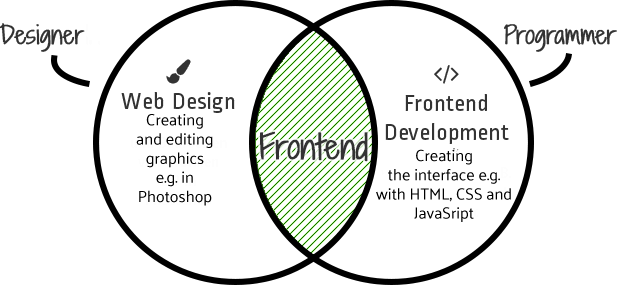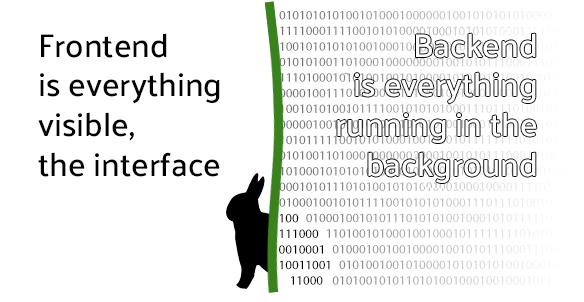Frontend definition:
Frontend is the presentation layer, it’s that part of an application, which the user can see. For example as a graphical user interface (short: GUI). The frontend is often a composed from to parts:
On the whole it can be noted that by talkig about a website, you also talk about its frontend. Everything you can see on an website, - fonts, colors, menus, buttons, tables and many more - were coded and/or assembled via html, css, JavaScript and for example the graphics for this site were produced with Photoshop. With this mix of coding and designing you have a wide range of possibilities for the individual designs for an application. The frontend closes the gap between interface and the actions which run in the background.
This makes an user interaction with the backend possible, which would otherwise be difficult or require a high level of specialized know-how
Recommendation — What is the hallmark of a really good frontend?
The frontend is the first thing a user sees.The first impression counts - “You never get a second chance to make a first impression“.
- The user should understand straightaway the clear objectives and issue of your application.
-
Your application should have a high positioning within search engines (SEO -Search Engine Optimization) to gain new potential customers.
-
There should be no problems and limitations on using different devices (responsive design).
-
Keep your content attractive. For a good overview you should
-
follow the motto "As much as necessary - as little as possible" - suited to your subject area
-
The most user usually are already familiar with applications and developed a sense of how they can expect specific elements. You should adapt this alignment (userfriendly interface). By using Icons the user is able to find the information quicker and in certain context.
-
Some individual characteristics are importent too, which sets your application apart from the others and the user is not bored with the mainstream. For the user is a clear structure is important to keep track, otherwise they might leave.
-
Content as well as the design should be kept clear, attractive or understandable. So for example, a clear line should be recognizable in the frontend. By colors and shapes you can create an attractive site for your customers. This should be based on a uniform corporate identity. Which means for example the definition of a particular color spectrum, fonts and font sizes.
-
Your site should radiate respectability. By a good frontend, a user often intuitively determines whether a page is trusting, whether it appeals to him and whether he wants to stay.
-
Consequently you should keep an eye on the current trends. a modern design ensures attention and also conveys their trend awareness.
-
The loading speed (Page Speed) of your application should be as fast as possible. Slow loading speed can make you lose (maybe also annoyed) users.
-
Social media is an important part of the Internet and the world today, so the integration and maintenance of such social media services should be an important part of your application. Once a user is connected to one of these services, you have the opertunety of providing additional information or repeatedly bring your application back in its minds. In addition, other potential userscould be reached by sharing via the social media pages.
-
The user should have the possibility to get in touch with you (e.g. via mail, phone or address).
-
Of course the essence when realizing all the points above is clean coding.
-
A good frontend frontend developer stands out by his good sense of design as well as having the programming skills to implement it. Here, experience as well as knowledge (for example about the needs-based structure of a user interface and a feeling for the intuitive use of an application) are important criteria for a good developer.
Frontend developer — fields of activity and qualifications
- Creation of designs for applications and their implementation, with focus on the frontend.
-
The solving of problems and optimization of applications.
-
The maintenance, management and development of existing customer projects.
-
Independent planning of the assessment of time and required effort, but also conception of solutions in close cooperation with you or a team.
-
Sound knowledge and routine in the use of different programming languages (for example: HTML5, CSS3, LESS, JavaScript, jQuery).
-
A deep understanding of usability and a user behavior
-
Throgh to rapid developments in this branch, he needs to ensure to keep track with all the new technologies an opertunities.
Syntax — What is the correct spelling? ‘Frontend‘ or ‘front-end‘?
…or even ‘Front End‘. It exists a lot different spellings, but they still have al the same meaning.Es existieren unterschiedliche Schreibweisen, doch alle haben die gleiche Bedeutung. By the time the term established, different spellings were used and never a 'correct' / unified designation was set.
- Therefore we consider all variants as correct and accept them equally.
(Its the same issue with backend, back end or back-end.)
Backend
the backend is decleared as the data access layer. That means it'sthe part of an application that is not visible to the user (contrasting the frontend).
It contains all programming of the application and the administration area.
for example on a website, you first encounter the frontend, ie the user interface. The frontend lets you interact with the backend. As soon as you enter information, they are transferred to a database on a server.
To make an application functional, you need the backend, which takes care of the implementation of the functions. You as an user can't see all those programming, for the functions that run in the background.
The person behind these steps is called the backend developer. He or she also uses programming languages such as PHP.



